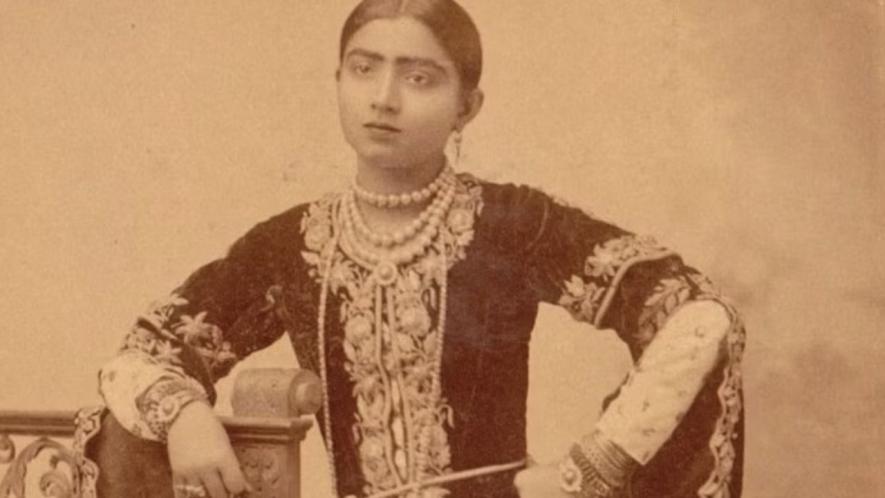150 Years of Gauhar Jaan: Celebrating a Star Performer Light Years Ahead of her Time

Gauhar Jaan
India’s very own prima donna, Gauhar Jaan, rose from the ashes to revolutionise the denigrated music industry through her feminism. Each of her 600 recordings paved the path for generations to follow, and her futuristic signature at the end of her songs set a benchmark for ownership of one’s intellectual property.
In the early 1900s, the scope for protecting a performer’s right in their own work seemed terribly bleak. In fact, it was not until 1961 when performer’s rights were finally given international recognition and kept on an equal pedestal to conventional authorship under the copyright law.
Adam Smith chalks out two primary reasons as to why performers were not given due recognition: one being social, and the other historical. Live performances were ‘short-lived’ and perishable, and thus deemed unworthy of copyright. Performers were socially outlawed and dismissed as ‘vagrants’.
Performance as protest
The ‘vagabondesque’ quality assigned to performers led to their professional talents being shelved under the label of unproductive labour for decades on end. Female performers, in particular, were treated with almost equal disdain as prostitutes. They were forced to survive on meagre daily wages. Some even frequented prisons for allegedly breaching terms of contracts, that could even include not performing up to the contractor’s mark.
Shifting our focus onto the then colonised Indian subcontinent, nautch girls, or female performers were in similar socio-cultural prevalence. These women were trained in music, dance and the art of writing poetry from a very young age, ultimately to provide entertainment to Nawabi elites as well as the eager officers of the East India Company.
Not only were they artistically versatile, their presence grew to become symbolic of oriental social luxury, allowing some of them to carry themselves in the best of charms and fashion. Despite economic prosperity, patriarchal notions of honour and chastity kept these virtuosos at the very fringe of mainstream society.
The late 19th century brought with it a terrible wave of conservative backlash that destroyed the livelihoods of hundreds of these young talents— the anti-nautch movement. This malign campaign against tawaifs and baijis entailed designation of the profession as immoral and against the socio-cultural fabric of the nation.
With already minimal autonomy over their performance coupled with a sudden wave of social marginalisation, what, apart from an iron will, made some of these women rise to such immeasurable fame and posterity in the early 20th century?
The gramophone, Gaisberg and a golden opportunity
When Frederick Gaisberg, lead agent of the Gramophone Company in India, first brought the gramophone (the company’s primary recording device was called the phonograph and colloquially referred to as the gramophone) to the sub-continent, superstitions of all sorts were afloat, about how recording into the alien apparatus could anger the gods above, or worse, capture the singer’s voice in its golden horn.
Skeptics harped that recording Indian classical music would ruin its very essence and authenticity. Truth be told, most had already found their cushioned spot in the market and were reluctant to jeopardise their image for a recording device still so novel and obscure to human beings.
Senior recording experts like Gaisberg were quick to grasp the fact that such drive and ambition could only be found in poor female performers, ready to shed their blood, sweat and tears to make difficult financial ends meet. The Gramophone Company began inviting some of these women, who had earned repute in the region, to record with them, offering a handsome ₹3,000 if the session culminated in a successful recording.
Indeed, it took one of these lowly nautch girls to turn the fate of Indian classical music on its very toes, as she became the first female artiste in the entire subcontinent to have a recording in her name!
Origins of an originator
Gauhar Jaan was born Eileen Angelina Yeoward to an English father and Armenian mother in the small town of Azamgarh in what was then United Provinces in British India. The marriage ultimately ended in a bitter divorce when Gauhar was of the slight age of six.
Her mother then took her to Benaras, where she was trained rigorously for nearly a decade by some of the greatest music and dance maestros of her time, including Brindadin Maharaj, Ali Baksh and Bhaiyya Ganpatrao. Their tutelage, and perhaps fate together molded our very own prima donna of India.
Many testified to Gauhar Jaan’s aura being unquestionable and looks unmatched: a full face, lustrous eyes, graceful figure and long black hair coupled with a golden voice. Some might have even described her as rather stubborn and arrogant.
Before other maestros could even digest the idea of the phonograph, she readily agreed to Gaisberg’s request to record a khayal (romantic poetry) in raag jogiya (Hindustani classical music). Thus began her recording sessions with the company in the Calcuttan winter of 1902.
Asserting ownership over her creative genius
During these recordings, she took upon herself the rather knotty task of condensing elaborate thumris (north Indian classical music) and bhajans (devotional songs) into a scant three-and-a-half-minutes that had, till then, only been sung for hours on end. Many still marvel at how Gauhar extracted the essence of every piece and strung it perfectly onto a 78-rpm record.
She preserved the integrity of the art, yet tweaked it just enough to fit the state-of-the-art technology. Keeping technicalities aside, it took copious amounts of courage for a woman to sit in a hotel room full of engineers and company agents, and experiment with both music and societal taboos at a time where purdah (segregation) was the norm.
These three-minute compressions of ragas and thumris not only became a commercial sensation in the market, they also began to be regarded as a completely new genre of modern classical music. By singing at a pitch and tempo never explored before, she created a new genre altogether.
Interestingly, Jaan would finish every recording with her signature statement, “My name is Gauhar Jaan”. While some may say this was done for the technicians in charge of compressing these recordings to identify the singer of the record, it also acted as a strong means of self-advertisement and promotion.
Besides, the seemingly coy tagline created proprietary exclusivity over her own work, one that was bold, distinctive and almost boastful of her identity and voice. A closer look and one understands how cleverly Jaan crafted a distinctive sound mark for herself to protect her art, and assert it as solely hers!
As a performer, she asserted what is today reckoned as the right of publicity which, broadly said, is the right of an individual performer to protect, own and exploit one’s identity. It is built on the premise that every performer has certain unique personality traits, such as voice, mannerisms or even stage name, that has potential for commercial profit, and thus must be protected from third parties trying to gain undue commercial advantage from it.
In fact, several decades from the era Gauhar lived in, a cine artist who gave back-to-back blockbusters protested unfair commercial use of the performers’ work and identity. This was decided in Fortune Films International versus Dev Anand and Another and its judicial response is widely criticised even today.
In the above case, the Bombay High Court refused to include performances within the ambit of ‘work’ in the Copyright Act, 1957, thereby sending a message loud and clear that performers were still considered mere vessels of an author’s work and thus incapable of creative originality. Performances, which had been part of Indian traditions for centuries, were not ‘art’ enough for Indian lawmakers up until 1995, when the Copyright (Amendment) Act, 1994 was implemented.
Thus, for a woman to claim such bold ownership over her property is an exceptional feat in itself for the early 1900s, but for her to demand and receive exclusivity over an intangible property boasts of feminist individualism almost an entire century ahead of its time.
Gaining bargaining control in the market
The previously transitory talent of a performer soon touched posterity after being captured in a gramophone and it managed to transcend transience itself. Between 1902 and 1920, the maestro managed to record nearly 600 songs in over ten languages, and these recordings eventually became her cradle of protectability.
She slowly positioned herself to dictate terms of contracts, including high rates of royalty and exclusivity over her original pieces. She would sometimes receive ₹3,000 for one performance, which was unheard of for a nautch girl to earn in a single sitting.
Historically, it was only the prima donna or the lead female singer of the opera that held so much authority over the terms of her employment. They were known to lead a life of extravagance and luxury by donning themselves in the latest fashion and demanding huge advance payments for each performance.
It isn’t surprising then, that Gauhar was given the title of ‘prima donna of India’. By 1905, the pop sensation had had her hand-painted portraits printed onto Austrian matchboxes. Not only that, she rode the postcard wave in the country with such pomp that other artistes were often referred to as their city or town’s ‘Gauhar Jaan’ on postcards to their name.
Talking about intellectual property, the concept of private ownership was previously unknown to many oriental traditions. In fact, a major chunk of the Global South’s scholarship around intellectual property alleges that its principles are a careful curation of values and principles meant to serve Western liberalist expansion. It is thus nothing short of phenomenal for a young Indian woman to have turned the idea on its very head.
A risk taker through and through, Gauhar’s grandeur was such that the then viceroy was known to have unwittingly bowed before her, mistaking her for a queen. Indeed, her royal presence and rate of royalties set a trend for performer rights that took nearly a century for Indian law to even come close to.
Gauhar taught us that each performer pours her creative self into a work of art, and in an industry that often swallows up talent for commercial gain, pomp and profit should never be at the cost of the identity and integrity of, or economic benefit to, an individual performer.
To resurrect the legend on her 150th anniversary one last time, Gaisberg’s borderline nostalgic account of his recording experiences with her seems perfectly fitting: “Hers were among the 600 records which proved a firm foundation for our new enterprise… Every time she came to record, she amazed us by appearing in a new gown, each one more elaborate than the last.
“She never wore the same jewels twice. Strikingly effective were her delicate black gauze draperies embroidered with real gold lace, arranged so as to present a tempting view of a bare leg and a naked navel. She was always bien soigné.”
Samridhi Shukla is a second-year undergraduate law student at the Hidayatullah National Law University, Raipur.
Get the latest reports & analysis with people's perspective on Protests, movements & deep analytical videos, discussions of the current affairs in your Telegram app. Subscribe to NewsClick's Telegram channel & get Real-Time updates on stories, as they get published on our website.

















